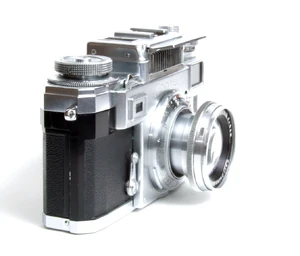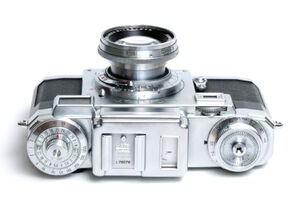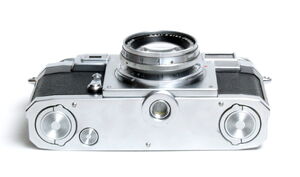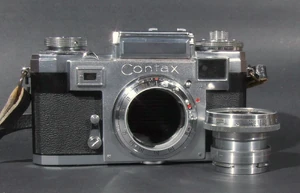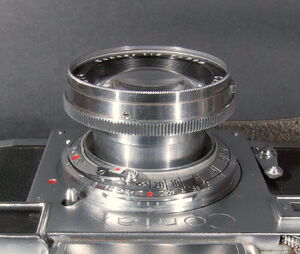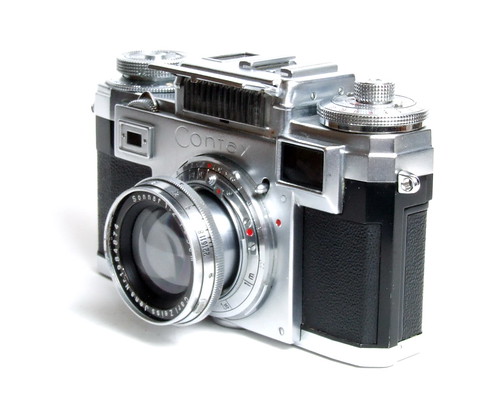
|
| Contax IIIa c.1956 , color dial w/ Carl Zeiss Jena Sonnar 50mm f/2 image by Süleyman Demir (Image rights) |
See also the articles Contax rangefinder lenses and Contax rangefinder
Contax IIIa is a 35mm film interchangeable lens rangefinder camera manufactured by Zeiss Ikon AG., Stuttgart, West Germany and produced between March 1951- August 1962.
Contax IIIa is the same camera with Contax IIa with a light meter. Compared to the prewar Contax II and Contax III, the Contax IIa and IIIa used the same lens mount with a completely re-engineered shutter mechanism, new body, and much improved chrome finish.
On earlier versions of the Contax IIa and IIIa cameras all the numbers on the shutter dial were in black and therefore is model was called Black Dial, corresponding to the Barnack Leica cameras like the IIIf. The so-called Color Dials were in production for a longer period than the Black Dials, 1953-62 (44.025 units) vs. 1951-53 (25.000 units). The earlier black dial Contax IIa and IIIa have a peculiar flash sync connection, from around November 1953 (CD) they have standard PC socket. As a consequence the release mechanism had to be redone. This was about the only major change in design during its production time. Other than that, from 1951 to 1962 there have been small changes in materials, exposure meter design and different lubricants.
The Contax IIa and IIIa are professional quality system 35mm Rangefinders with a large system of lenses and accessories, that some considered the best 35mm lenses during the 1950's. The Contax IIa and IIIa has a superb mechanical fit and finish, many believe better than even the legendary Leica M3.
Specifications[]
- Lens release: pressing spring catch when the red dots are aligned on the lens flange and simultaneously turning the lens clockwise, or turning the focus wheel counter clockwise.
- There is a second outside bayonet mount on the focusing helicoid of the body for other than 50mm lenses
- Focusing: by a thumb ring on the left-front of the camera via helical built in the body, the yellow rangefinder images must be match in the viewfinder, scale and DOF scale on the focusing helicoid on the body
- Shutter: all metal focal plane shutter with aluminium shutter curtains, vertical traveling, speeds: 1-1/1250 +T & B
- Setting: ring and dial beneath the winding/cocking knob, lift and turn to desired setting, for T: the shutter closes by turning the speed dial to B, when on T, without lifting.
- Shutter may be set to any speed while either tensioned or untensioned.
- Shutter release: on top of the cocking knob, w/ cable release socket
- Cocking knob: also winds the film, on the left of the top plate
- Frame counter: on the cocking knob, advance type, manual setting
- Viewfinder: coupled view and rangefinder
- Exposure meter: photo-electric selenium cell exposure meter, uncoupled, w/ a lid on its light taking window
- Film speed range: 9-30 DIN (6-800 ASA),
- Setting: by inner thumb ring on the meter settings dial knob
- Exposure setting: matching needle and black diamond mark in the window on the top plate, adjusts by turning a big, complex dial knob on the left of the top plate, shows DIN scale, aperture and speed scales, speed setting possible from 60 sec. to 1/1250 sec.
- Re-adjustment of exposure meter is possible by a screw on the back side, close the meter lid, turn the meter dial counter-clockwise as far as go, the meter needle must point the black dot in the window, if not, adjust it by turning the screw
- Re-wind knob: on the meter setting dial, for easy handling it can be lifted about 1cm, turns when winding
- Re-wind release: a knob on the bottom plate, film rewinds by pressing the button and simultaneously turning winding knob
- Flash PC socket: on the back side of the camera, synch 1/50 (orange on the speed dial) for electronic flash and 1/100 and over (red) for bulb flashes
- Cold-shoe (accessory shoe for additional viewfinders, flash guns etc.)
- Engravings in the cold-shoe: Zeiss Ikon, Stuttgart, Germany and serial no.
- Self-timer: possible three delay times setting, and may be selected on T,B, or any other speed.
- Back cover: removable with the bottom plate, open by two folding levers on the bottom plate
- Relief on the back cover leatherette: Zeiss Ikon logo
- Tripod socket: 3/8
- Strap lugs
- Body: metal; Weight: 800g
- Serial no. On the cold-shoe and inside of the camera.
